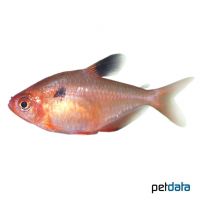Serpae Tetra (Hyphessobrycon eques)
| Serpae Tetra Hyphessobrycon eques | |
|---|---|
| Name | Serpae Tetra |
| Name Lat. | Hyphessobrycon eques |
| Family | Characins |
| Family lat. | Characidae |
| Order | Characins |
| Order lat. | Characiformes |
| Origin | Brazil, Paraguay |
| Habitat | Streams, ponds |
| Diet | Carnivore |
| pH | 5.5-7.5 |
| Behavior | Semi-aggressive |
| Keeping | Group, school |
| Care Level | Moderate |
| Reproduction | Egg scatterer |
| Breeding | Moderately difficult |
| Life Span | 4-5 years |
| Protection | No |
| Metric Units | |
| Size | 4 cm |
| Temperature | 22-28 °C |
| Hardness | 3-15 °dH |
| Aquarium | ~ 80 l |
| US Units | |
| Size | 1.6" |
| Temperature | 72-82 °F |
| Hardness | 53-267 ppm |
| Aquarium | ~ 20 gal |
Distribution and habitat
The Blood Tetras originate from the southern tributaries of the Amazon and from the upper Rio Paraguay in Brazil and Paraguay. They live in the still water of rivers and streams as well as in lakes with dense riparian vegetation and tree roots and branches protruding into the water.
Maintenance
The aquarium should have a varied, partly dense planting, with shelters and hiding places (roots) and provide sufficient swimming space. A dark substrate covered with some foliage (e.g. sea almond leaves) and shaded light (floating plants) is ideal.
No ammonia, ammonium and nitrite should be detectable, the nitrate value should not exceed 100 mg/l. To ensure water quality and oxygen content, a filter and heater adapted to the aquarium size is required, as well as lighting for the species-appropriate day-night rhythm of the animals.
Diet
In nature they feed mainly on small insects and larvae. The food supply consists of live, frozen and dry food. For a balanced diet, feed once a day with a high-quality, protein-rich dry food (flakes, granules, micro-pellets) as well as cyclops, moina, daphnia, artemia, mosquito larvae, etc. (live or frozen)
It is recommended to feed small portions several times a day. Only feed as much as will be eaten within a few minutes. A regular and varied diet promotes health and increases resistance.
Behaviour and compatibility
They are lively fish and should only be socialized with other lively fish. Care should be taken with long finned fish. At least 5, but preferably much more blood tetras should be kept together.
Basically, only mutually compatible fish species with similar water condition and water temperature requirements should be socialized.
Sex dimorphism
The male has a flat belly compared to the female. The female is stockier and appears more rounded
Reproduction and breeding
In soft, slightly acidic peat water they usually spawn between fine-feathered plants (free spawners). The larvae hatch after approx. 24 hours and swim freely from the 5th day.
Juveniles must be fed several times a day with special rearing food (dust food). In community tanks breeding is hardly possible, because the spawn is easy prey.
Important
They are considered fin twitchers. Kept in a group, other fish are rarely bothered and their occasionally quarrelsome behavior remains intraspecific.
The foliage (sea almond tree, oak, etc.) enriches the water with humic substances, naturally lowers the pH and, when rotting, promotes the development of microorganisms, which are a valuable secondary food source
The well-being of the fish should be monitored regularly. Temperature should be checked daily, pH, hardness and nitrate levels should be checked at least every 14 days. Regular partial water changes are recommended, even when contaminant levels have not yet reached the upper limit. Sudden changes in water quality should be avoided. Newly introduced fish must be accustomed slowly to the water in the aquarium.
Further literature can be found in your pet store.
References
Text: petdata; Image: petdata
Source: BMELV (1998): Tierschutzgutachten - Haltung von Zierfischen (Süßwasser); RIEHL & BAENSCH (2006): Aquarien Atlas Bd. 1, Mergus Verlag; ENGELMANN (2005): Zootierhaltung - Tiere in menschlicher Obhut: Fische, Verlag Harri Deutsch
- Gemäß § 21 Abs. 5 Tierschutzgesetz idgF
